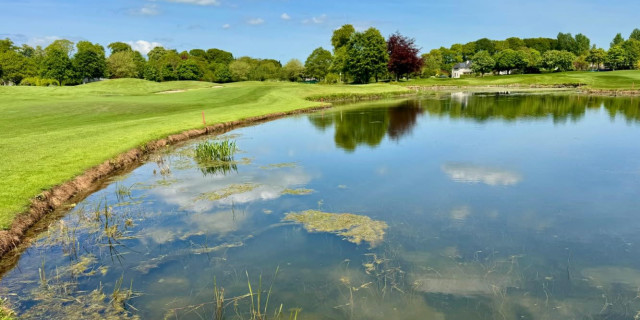
Darlington Golf Club Review
Post by Golf Journalist Josh Carr
One of the hotly anticipated golf events of the year is always the Masters at Augusta National. The tree lined fairways and incredible greens are what are most memorable from this course, however, just about all amateur golfers will never get the opportunity to play there. However, in the North East of England is Darlington Golf Club, with its course that was designed by the same person who designed Augusta National and shares many similarities to the Masters’ track.
Pre-round thoughts
As you make your way up the drive to Darlington Golf Club, it is quite hard to imagine that there is a brilliant golf course just around the corner. The clubhouse, although reasonably small, is very friendly and welcoming and I would definitely recommend taking advantage of the new catering facilities. If you’ve already eaten upon arrival then you can take advantage of the brand new pool table and dart board, or sit and enjoy Sky Sports on the big screen.
Before arriving at the course I’d heard a lot about the quality of the greens at Darlington Golf Club. The putting green, although not majorly undulating, gave a great impression of the pace these greens posses and handily was the same pace as the ones on the course.

The Course
Darlington Golf Club was founded in 1908 and designed by world-renowned golf course designer Dr Alistair Mackenzie. You may recognise the name as he designed Augusta National, and this 18-hole parkland course has many similarities to the home of the Masters.
The par 70 course boasts a unique parkland layout and although only just over 6,000 yards, your putter will have to be red hot in order to score well on these majorly undulating and quick greens. The densely tree-lined fairways mean you must be accurate off the tee to add.
The front nine
The course begins with a generous par-4 to ease you into the round. The hole is only 348-yards off the white tees and has a reasonably wide fairway, but it is when you approach the green you get your first feel for Alistair Mackenzie’s exquisite green design. The green is shared with the 9th hole and has some major undulations meaning your putter will have to be hot from hole one.
The par-4 2nd hole deserves its stroke index of 3, especially off the white tees, as it measures at 434 yards and requires two accurate shots to hit the green. For the big hitters, be aware of the ditch that runs across the middle of the fairway, as you may run out of room off the tee.
The first par-3 comes at the 3rd hole and is a neat little hole that runs along side the car park and drive. Although only 150-yards, the green is really tricky here. If you get it on the correct tier you should be extremely proud. Anything on the wrong tier can leave a very testing putt indeed. This is another fine example of Mackenzie’s great green design.
The 4th hole is the final par-4 on the front nine and requires some tactical thinking off the tee. The hole is a dogleg left, with out of bounds running along the entire left hand side of the hole. Most golfers play safe with an iron down the right hand side, that only leaves a short iron to the large green that runs entirely downhill, back to front.
Holes five to nine offer a unique layout as there are three par 5’s and two par 3’s, something which is quite unusual, but enjoyable nonetheless. The 5th hole requires two big hits if you are to reach this 534-yard par-5 in two. The drive is reasonably open but the fairway gets tighter and tighter the closer you get to the green, so if you are going to go for it you must be accurate.
Stroke index one comes at the par-5 6th hole and again, like the 5th, requires two big hits if you are to reach in two, especially if the wind is blowing into as it usually does. A strategically placed bunker about 30-yards short of the green tends to deter people from going for the green. The green is arguably the biggest challenge on this hole as it features some extreme slopes and it can often be difficult to get your approach shot close.
After the hardest hole on the course, comes the second easiest. The par-3 7th is only 143-yards but is a nice looking hole as you play into a coliseum of large pine trees. A nice looking hole and a good birdie chance if you’re good with your short irons.
The 8th hole is another hole that requires a bit of thinking off the tee. There are two bunkers in the middle of the fairway that are reachable for the longer hitters so requires an iron off the tee. Trees both side of the fairway make this approach a daunting one, but the green is reasonably flat and large giving those who are brave enough to go for it a better chance of finding the putting surface.
The front nine ends with a tricky par-3 that shares its green with the 1st hole. The hole is just over 160-yards off the white tee and although it is a wide green, it isn’t a very deep one and features many undulations. If you get on the correct side of these undulations then you can set up a great birdie chance.
The back nine
To begin the back nine is a relatively straightforward par-4, as long as you avoid the out of bounds down the left hand side. The fairway is almost in a bowl shape so most drives gather towards the middle of the fairway, leaving just a short approach. If you took advantage of the halfway house phone on the tee then you will be able to smell your food cooking in the clubhouse behind the green.
The 11th hole is arguably one of the more memorable holes on the course due to its extreme length for a par-4. The hole is 462-yards off the back tee and suits the golfer who hits the ball right to left, as the hole is a slight dogleg to the left. If you do manage to get a good drive away, you will need to be accurate with a long iron, or even a wood, in order to hit this relatively small green, with two tiers. This is a great par-4 that really does test your long game.
Next up at the 12th hole is the shortest par-3 on the course, and arguably the easiest. The hole is just 130-yards long and the only real test is the slight slopes on the greens that can move any ball with too much spin on it off the green.
The 13th hole is another reasonably long par-4 as it stands at 420 yards and plays slightly uphill. Out of bounds runs along the left hand side so you will often see golfers bailing out right, which leaves an even longer approach shot. The green is relatively small and falls away on the left side making it a difficult one to hit. This hole thoroughly deserves its stroke index of 4.
You must be wary of the small wooded area on the left of the 14th hole as it could result in a lost ball. For this reason most golfers bail out down the 13th fairway on the right hand side as this often still leaves a shot into the green. On the approach you must also be aware of the pond that sits at the back left of the green as everything falls towards it. A relatively straightforward par-4 at first glance, but there are few hidden hazards that could cause a few problems.
The testing stretch
The final four holes at Darlington require great concentration if you are going to keep up your good score, mainly because of the two long par-3’s you have to contend with.
The 15th hole is where the first of these two par-3’s appears. The hole plays 203-yards off the whites and is ever so slightly uphill to a green that slopes from back to front. If you manage to get your tee shot on the green, you are better off below the hole otherwise you will leave a slick putt down and across the slope.
If you can shape your driver from right to left then the par-5 16th hole is a great birdie opportunity, as you will put yourself in position to hit the green with your approach. However, the green does have a severe slope so you must be tactical and leave your approach below the hole.
The 17th hole is another tough par-3 as it measures over 200-yards, but the main feature of this hole is the signature Mackenzie green that has many sharp undulations. This green is often described as a roller coaster of a green and you must be the correct side of the hole to have any chance of a two putt. Due to its distance this is often hard to do and really is a tough hole to take on at the end of your round.
The final hole, although relatively short, can cause some problems. For starters, there is out of bounds down the left hand side and the fairway falls away towards it. Most golfers play an iron for safety or bail out onto the 11th, if you choose the latter, you will leave a tough approach, as the green will be running away from you. Again, the green has several undulations so if you hit the green, don’t expect a simple two putt. A nice finish to a simple, yet challenging golf course.
Verdict
Although this course is reasonably flat and arguably doesn’t offer outstanding views, it does offer some of the best greens in the area and is always presented in top condition. It has everything golfers want with its lush fairways and fast greens and is definitely worth a play if you’re in the area.
The members always offer the warmest of welcomes and, without a doubt, you will enjoy this course. There are several options for visitors starting from £22.50 per person for 18 holes, however I would definitely recommend taking advantage of one of the catering deals on offer as well as the golf.
Related Content:

















